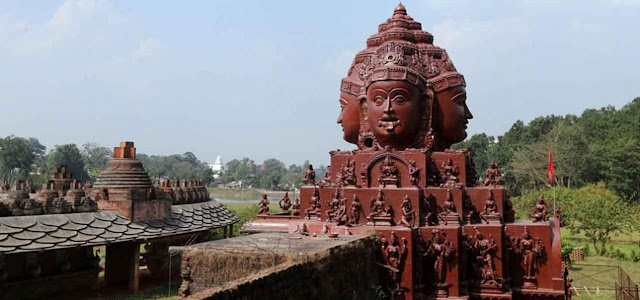Amarkantak, often refereed to as Tirtharaj or King of
Pilgrimage is situated at an altitude of 1000 m in Anuppur district of Madhya
Pradesh (MP). Amarkantak is located at the junction of the three central Indian
ranges of Vindhyas, Satpuras and Maikal.
The mighty rivers of Sone and Narmada originate from
Amarkantak. According to legend Sone and Narmada were to marry each other but
Sone refused and flowed eastwards to join the Ganges near Patna.
Narmada took the opposite direction and flowed westward
through the entire stretch of central India and finally draining into the
Arabian Sea.
Amarkantak is a pilgrimage not only for the Hindu but
also for the Jains and the entire town is dotted with innumerable temples.
(see photo), the
temple built to mark the source of the Narmada River, is the holiest spot in
the whole of Amarkantak.
This temple complex consisting of a series of small white
washed temples built around a water body, which marks the source of the mighty
Narmada. Sadly these temples, like most of the temples of Amarkantak, are new
structures.
The only old structures in the ancient pilgrimage of
Amarkantak are the Ancient Temples of the Kalachuri Period, located bang
opposite the Narmada Udgam Temple complex.
The temples were built by the Kalachuri kings, who ruled
central India during the 10 – 12 th century.
According to legend Shankaracharya built the Surya Kunda
in Amarkantak, in 8th century AD, to specify the origin of Narmada.
It is also said that Shankara installed the idol of lord
Shiva in Pateleshwar Temple, strangely the Pateleshwar temple was built much
later during the reign of Kalachuri King Karnadeva (1041 – 1073).
The temple complex located next to the ancient man made
water body has several structures belonging to the Nagara style of
architecture.
The Pateleshwar Temple is crowned with a pancharath
sikhara and has a pyramidal mandap.
The Karna Temple, the largest and the most prominent
temple in the Kalachuri Temple complex, is crowned with a towering ornate
sikhara.
The complex also contains several other temples including
the Johila Temple, Vishnu Temple and Shiva Temple. Another interesting
structure in the Kalachuri Temple complex is the Pancha Math Temple. A series
of five small temples, of different architectural style, located on a single
raised platform.
Today the Kalachuri Temple complex is a protected
monument under the Archaeological Survey of India (ASI) and the complex is very
well maintained with manicured lawns and landscape gardening.
Sadly it is hardly visited by the thousand of pilgrims,
thronging Amarkantak, the Tirtharaj or King of Pilgrimage


No comments:
Post a Comment